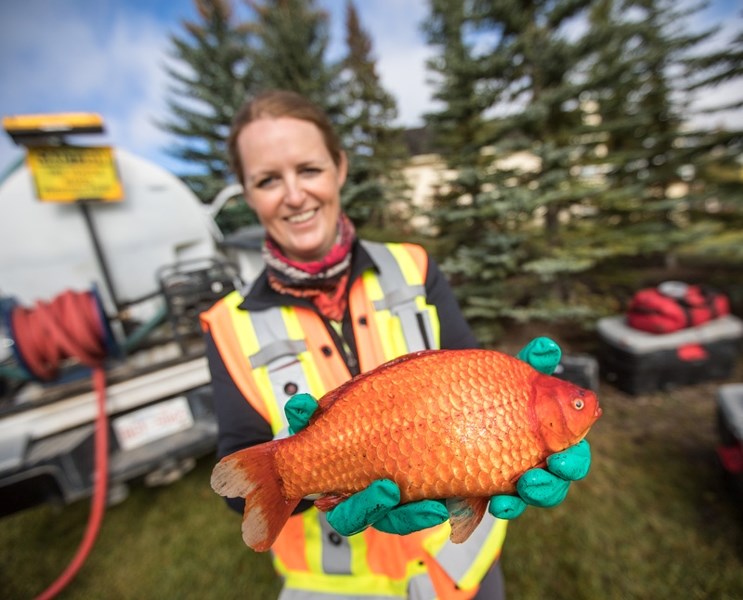Thousands of goldfish have been removed from storm ponds after three rounds of chemical treatment at two locations in Okotoks.
Storm ponds in Drake Landing and Crystal Ridge became overrun with goldfish after Okotoks residents deposited their domestic pets into the water. When lowering water levels and hoping the fish would freeze over winter didn’t work, the Town was forced to research chemical methods to remove the fish from its storm ponds.
According to Okotoks parks manager Christa Michailuck, goldfish pose a threat to native fish species in the Sheep River should they make their way through the storm water system.
The Town chose to apply rotenone to the infected ponds. After lowering water levels and turning off the valves that allow water to flow through to the water, rotenone was added to the water to eradicate the goldfish.
“It went well,” said Michailuck. “We’ve completed the two treatments on the Drake Landing pond and the first treatment on the Crystal Ridge pond, so we’ll have one more to go on Crystal Ridge.”
She said the first application in Drake Landing was not 100 per cent successful in wiping out the fish. Some large goldfish were found swimming through the water in between the first and second applications, she said.
Larger fish are less susceptible to the treatment, she said. After the second treatment a couple of larger fish were removed from the water, and the pond will be monitored over the next two weeks to ensure the applications worked.
“The goldfish are certainly more resilient than the native fish would be,” said Michailuck.
Michailuck said they use what they refer to as “sentinel fish” to check on the toxicity of the storm ponds and measure whether the rotenone applications work. These test fish are native species, which are more susceptible to the treatment. They’re placed in traps and set in different locations through the pond.
“Then we pull those traps up after the treatment and check to see if those fish survived or not, and that’s a good indication our treatment is effective,” she said. “
The first application in Crystal Ridge also went well, she said, with thousands of goldfish being removed from the water on Sept. 23.
Several five-gallon pails were filled with fish, she said. The count on one of the pails was 500 goldfish.
Parks crews will continue to check the status of goldfish in the Crystal Ridge pond over the next few days. The toxicity level of the water will also be monitored, so the Town can plan for its second application in the storm pond.
“We have to wait until the rotenone has degraded to a point before we do the second treatment so we don’t exceed the four parts-per-million rate,” said Michailuck. “We’ll be checking the toxicity of the water with sentinel fish in the coming days, and once those fish are surviving then we can arrange our second treatment.”
She said rotenone degrades quickly in warm conditions, but with cooler nights and mornings it could take a little longer for the chemical level to dilute. It can take anywhere from a few days to a week or so, she said.
Though the first treatment in Drake Landing was completed by Alberta Environment and Parks at no charge to the Town, Michailuck said each of the rotenone treatments costs about $6,500.
Some of the cost is covered by a $10,000 grant from the Alberta Conservation Association, she said.
She urges residents to take care to dispose of their fish carefully. Though many pet stores don’t take them back, she said family or friends may be able to help out, or euthanization can be considered.
“We just really hope not to find fish in other ponds because it is quite a bit of work and expense, the control efforts of it,” said Michailuck. “There are better ways to handle pets you no longer want to care for.”




